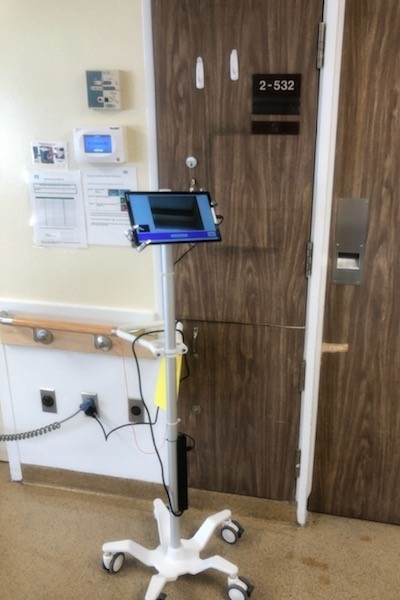Video call system to reduce PPE demand
March 11, 2021
Share
The patient call button is a piece of equipment that is taken for granted in most hospitals. In fact, the technology behind it hasn’t been updated in decades.
But now, Queen’s researcher Michael Greenspan, Department of Electrical and Computing Engineering, is running a pilot project at Belleville General Hospital that aims to upgrade the call button system with some modern technology.
“Basically, there is a computer tablet in a patient’s room, and one outside of the room for a health care worker to use,” says Dr. Greenspan. “The patient and nurse can interact safely, and it saves the hospital staff from changing into and out of Personal Protective Equipment (PPE).
While certain patient interactions still require health care providers to be physically present in the room, many routine interactions, like ones that are currently handled through hourly or intentional rounding, can be done as effectively and more efficiently, through a face-to-face video call conversation.

The COVID challenge
One of the main challenges hospitals are facing throughout the COVID-19 pandemic is a shortage of PPE, especially masks, N95 respirators, goggles, visors, and gowns.
“Even though hospitals are re-using or extending the use of some of these PPE elements to conserve these limited products, PPE shortages remain prevalent across Canada and worldwide and these shortages are likely to be a concern for the foreseeable future,” says Dr. Greenspan. “Whereas other efforts have been oriented to increasing the supply of PPE, we’ve focused on the other side of the equation, ad are working towards decreasing the demand through the use of this interactive technology.”
The research was initially funded through the Ingenuity Labs Research Opportunities Seed Fund, and then through the Ontario Centres of Excellence VIP project, which included a contribution from HHAngus and Associates Ltd, an engineering firm with a focus on health care facilities. The project involves collaborators Dr. Jennifer Medves (School of Nursing), Dr. Dick Zoutman (Medicine), as well as colleagues from Queen’s Ingenuity Labs. Several other students and recent Queen’s graduates are also working on the project, including an ECE MEng recent graduate, software developer and team lead Ankit Dhanda.
Beyond the pandemic
Officials at Belleville General Hospital are keeping the system in place for now. Dr. Greenspan says the researchers have developed a new version, with a number of additional and advanced features based on the feedback that they have received, and are on track to install this new version in the spring.
Plans to evolve the patient call button were well underway when the COVID-19 pandemic hit and, once it subsides, the research team is hoping to circle back to the original vision of re-engineering the call button system entirely. The original vision involved adding in a series of sensors to monitor the patient and their environment, and then processing the data with Artificial Intelligence and Machine Learning methods, in order to detect and predict unsafe events or conditions. The technology could one day provide a better way for health care workers to interact with and monitor patients
“We hope to not only apply a different version to a hospital setting, but expand the system even further,” says Dr. Greenspan. “The technology could be used in the Intensive Care Unit of hospitals, because the patients there are especially vulnerable and need to be protected from infection,” says Dr. Greenspan. “Overall, this technology upgrade could lead to better efficiencies, better health outcomes, and higher patient and health care worker satisfaction.”